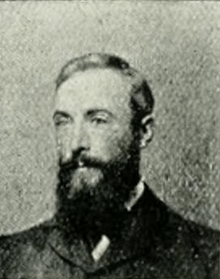André Dauchez
| André Dauchez | |
|---|---|
 Photographic portrait (before March 1900) | |
| Born |
1870 Paris |
| Died | 1948 |
| Nationality | French |
| Education | Académie Julian |
| Known for | Landscape paintings and etchings |
| Spouse(s) | Marie-Thérèse Le Liepvre |
| Awards | Carnegie Prize |
André Eugène Dauchez (17 May 1870 - 15 May 1948), born in Paris was a French painter, watercolourist, pastellist, engraver, draughtsman and illustrator known for landscapes, waterscapes and seascapes.[1]
Biography
Born in a family of lawyers, André Dauchez showed early predispositions for graphic arts. His early influence was the works of Gustave Doré.
While pursuing his studies, he was encouraged in the way of art by his mother, who found Gaston Rodriguez, an artist-engraver who from 1885 to 1887 taught and educated the young man's ability to see and transcribe only the essential.
André Dauchez never abandonned this mode of expression, handling with dexterity the technique of etching. In 1887, his teacher allowed him to present his work after a painting by Eugène Isabey at the Salon des Artistes français. It was the first success for the young man of seventeen who received the encouragements of his peers. Between the years 1887 and 1893 André Dauchez continued working on etching and painting and further studied with Luc-Olivier Merson and at the Académie Julian.[2]
The influence that nourished the engraved works of André Dauchez was Rembrandt's work. André Dauchez had led a comprehensive study of the master and learned the art of light and the importance of values of white and black in a landscape rendering.
He also studied Dutch landscape painter of the seventeenth century Jacob van Ruisdael, as well as some of his contemporaries and friends like Georges Gobo, Raoul André Ulmann, Albert Decaris, Charles Jonas, Pierre-Louis Moreau.[3]
When his sister married artist Lucien Simon, Dauchez was introduced to a circle of other artists like Émile-René Ménard, Edmond Aman-Jean, Charles Cottet, George Desvallières, Maurice Denis and above all discovered coastal Brittany and Cornouaille, the bay of Douarnenez, Belle-Île-en-Mer, Bénodet, the river Odet and the charm of the area. Dauchez was seduced by the lines and force of the landscape. From then on, he will dedicate his work to transcribe the many faces of the Finistère' Cornwall which inspired his best pieces.
Art critic André Chevrillon in Drogues et Peintures , Paris, 1940, describes the work of André Dauchez as an "expressive and faithful portrait of Brittany". From the end of 1893, and for over half a century André Dauchez will find an inexhaustible source of inspiration in the landscapes of the Cornish coast: heath, dunes, villages, fishermen, estuaries and coves lined with pine trees, edges of coastline and rivers, rocks at low tide, open landscapes are his favorite motifs. He was an outdoor painter who described the effects on his soul of trees, stones, water and light. André Dauchez' works often present a cluster of trees, a trail, or a body of water, while in the background fades the rest of the composition with contrasts of light and shadow giving intensity to his work in a composition in which one feels life vibrating, transcribing the different effects of shade, sun or wind that alter the appearance of a landscape.
Dauchez' talent lies in landscape drawing allied to a subtle artistic sensibility.[4]
Collections
- Musée d’Orsay[5][6]
- Chicago Art Institute [7]
- Smithsonian American Art Museum[8]
- Tokyo National Museum of Western Art [9]
- Finnish National Gallery [10]
- British Museum[11]
Honors
- In 1900, Silver medal from the Exposition Universelle (1900)
- and Carnegie Prize
- André Dauchez is named knight of the Legion of Honour in 1911 and officer in 1932.
- In 1920, he is a jury member at the Carnegie Institute.
- He was appointed official painter of the Navy in 1922.
- He was elected President of the Société Nationale des Beaux-Arts in 1938 succeding Jean-Louis Forain
- He was elected member of the Academy of Fine Arts, engraving' section in 1938.
Publication
- Notice sur la vie et les œuvres de Émile Brulant, Paris, Firmin-Didot, 1940
References
- ↑ Benezit Dictionary of Artists
- ↑ (fr) Site AJ records
- ↑ (fr)Stéphane Brugal -Brugal-antiquités
- ↑ (fr) Dacier, Émile in La Revue de l'art ancien et moderne , Paris 1923
- ↑ Mistral/Joconde
- ↑ Mistral Arcade
- ↑ Artic.edu
- ↑ SAAM
- ↑ National Museum of Western art
- ↑ (fi) kokoelmat.fng.fi
- ↑ collection.britishmuseum.org
